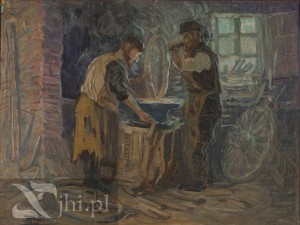A few weeks ago I received an email with 17 photographs of my great-grandfather’s paintings held by the Jewish Historical Institute (ZIH) in Warsaw. The Institute has 52 of Moshe Rynecki’s paintings under their control. I am frequently asked how they came into possession of my great-grandfather’s works. The answer is that I do not entirely know. I know their records show they obtained many of his pieces in 1946, but that they also acquired others at different points in time. I am including here a description of the Institute as explained on Wikipedia as well as a photograph of one of the pieces held by ZIH.
The Jewish Historical Institute was created in 1947 as a continuation of the Central Jewish Historical Commission, founded in 1944. The Jewish Historical Institute Association is the corporate body responsible for the building and the Institute’s holdings. The Institute falls under the jurisdiction of the Ministry of Culture and National Heritage. In 2009 it was named after Emanuel Ringelblum. The institute is a repository of documentary materials relating to the Jewish historical presence in Poland. It is also a centre for academic research, study and the dissemination of knowledge about the history and culture of Polish Jewry.
The most valuable part of the collection is the Warsaw Ghetto Archive, known as the Ringelblum Archive (collected by the Oyneg Shabbos). It contains about 6000 documents (about 30 000 individual pieces of paper).
Other important collections concerning World War II include testimonies (mainly of Jewish survivors of the Holocaust), memoirs and diaries, documentation of the Joint and Jewish Self-Help (welfare organizations active in Poland under the occupation), and documents from the Jewish Councils (Judenräte)
The section on the documentation of Jewish historical sites holds about 40 thousand photographs concerning Jewish life and culture in Poland.
The Institute has published a series of documents from the Ringelblum Archive, as well as numerous wartime memoirs and diaries.
